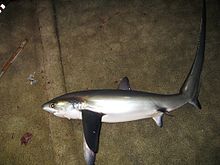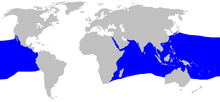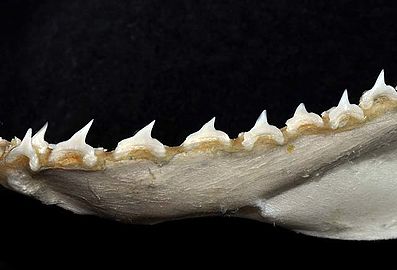Pelagic thresher
| Pelagic thresher | |
|---|---|

| |
| Scientific classification | |
| Domain: | Eukaryota |
| Kingdom: | Animalia |
| Phylum: | Chordata |
| Class: | Chondrichthyes |
| Subclass: | Elasmobranchii |
| Subdivision: | Selachimorpha |
| Order: | Lamniformes |
| Family: | Alopiidae |
| Genus: | Alopias |
| Species: | A. pelagicus
|
| Binomial name | |
| Alopias pelagicus H. Nakamura,1935
| |

| |
| Geographic range (blue) | |
Thepelagic thresher(Alopias pelagicus) is a species ofthresher shark,familyAlopiidae;this group of sharks is characterized by the greatly elongated upper lobes of theircaudal fins.The pelagic thresher occurs in the tropical and subtropical waters of theIndianandPacific Oceans,usually far from shore, but occasionally entering coastal habitats. It is often confused with thecommon thresher(A. vulpinus), even in professional publications, but can be distinguished by the dark, rather than white, color over the bases of itspectoral fins.The smallest of the three thresher species, the pelagic thresher typically measures 3 m (10 ft) long.
The diet of the pelagic thresher consists mainly of small midwater fishes, which are stunned with whip-like strikes of its tail. Along with all othermackerel sharks,the pelagic thresher exhibitsovoviviparityand usually gives birth to litters of two. The developingembryosareoophagous,feeding on unfertilized eggs produced by the mother. The young are born unusually large, up to 43% the length of the mother. Pelagic threshers are valued bycommercial fisheriesfor their meat, skin, liver oil, and fins, and are also pursued bysport fishers.TheInternational Union for Conservation of Natureassessed this species asendangeredin 2019.
Taxonomy and phylogeny[edit]
The pelagic thresher was originally described by JapaneseichthyologistHiroshi Nakamura on the basis of three large specimens, none of which was designated atype specimen.He illustrated one of the three specimens in his paper, "On the two species of the thresher shark from Formosan waters", published in August 1935. Nakamura also separately illustrated and described afetus,thatLeonard Compagnolater concluded was probably of a common thresher. Several authors, including Gohar and Mazhar (1964, Red Sea), Kato, Springer and Wagner (1967, Eastern Pacific), Fourmanoir and Laboute (1976, New Caledonia), Johnson (1978, Tahiti), and Faughnan (1980, Hawaiian Islands) have published illustrations of "common threshers" that were in fact pelagic threshers.[3]
Anallozymeanalysis conducted by Blaise Eitner in 1995 showed that the closest relative of the pelagic thresher is thebigeye thresher(A. superciliosus), with which it forms aclade.[4]Thespecific epithetpelagicusis from theGreekpelagios,meaning "of the sea". Anothercommon nameis the smalltooth thresher.[5]
Distribution and habitat[edit]
Due to confusion with the common thresher, the distribution of the pelagic thresher may be wider than is currently known. It ranges extensively in theIndo-Pacific,with scattered records fromSouth Africa,theRed Sea,and theArabian Sea(offSomalia,betweenOmanandIndia,and offPakistan), toChina,southeasternJapan,northwesternAustralia,New Caledonia,andTahiti,to theHawaiian Islands,California,and theGalapagos Islands.[3]The North Pacific population shifts northward during warmEl Ninoyears.[6]Analysis ofmitochondrial DNAhas shown extensivegene flowwithin the eastern and western Pacific pelagic thresher populations, but little flow between them.[7]
The pelagic thresher primarily inhabits theopen ocean,occurring from the surface to a depth of at least 150 m (492 ft).[5]However, it occasionally comes close to shore in regions with a narrowcontinental shelf,and has been observed nearcoral reefdropoffs orseamountsin the Red Sea and the Gulf of California, and offIndonesiaandMicronesia.It has also been known to enter largelagoonsin theTuamotu Islands.[8]
Description[edit]
The pelagic thresher is the smallest of the thresher sharks, typically 3 m (10 ft) in length and 69.5 kg (153.3 lb) in weight, and usually not exceeding 3.3 m (10.8 ft) and 88.4 kg (194.9 lb).[5]Males and females attain known maximum lengths of 3.5 m (11.5 ft) and 3.8 m (12.5 ft), respectively.[9]A record of 5 m (16.4 ft) is dubious and may have resulted from confusion with other thresher species. This species has a fusiform body (wide in the middle and tapered at the ends) and a very slender uppercaudal finlobe nearly as long as the rest of the shark. Thepectoral finsare long and straight with broad, rounded tips. The firstdorsal finis placed halfway between the pectoral andpelvic fins,and is of comparable size to the pelvic fins. The second dorsal andanal finsare tiny.[3]
The head is narrow with a short, conical snout and a distinctive "pinched" profile when viewed from below. The eyes are very large in juveniles and decrease in relative size with age. No furrows occur at the corners of the mouth. Theteethare very small, numbering 21–22 rows on each side with a symphysial (central) row in the upper jaw and 21 on each side without a symphysial row in the lower jaw. Five to 11 rows of posterior teeth are present. The teeth are smooth-edged, with oblique cusps and lateral cusplets on the outside margins.[3][5]The body is covered with very small, smoothdermal denticleswith flat crowns and cusps with parallel ridges. The coloration is an intense dark blue above and white below; the white does not extend to above the pectoral fins. The color rapidly fades to gray after death. The dark pigment above the pectoral fins, the rounded pectoral fin tips, and the absence of labial furrows separate this shark from the common thresher.[5][6]
-
Pelagic threshers can be identified by the color above their pectoral fins
-
Jaws
-
Teeth
-
Teeth
Biology and ecology[edit]
The pelagic thresher is an active, strong swimmer and has been known to leap clear of the water (five times in a row on one documented occasion).[8]Predatorsof the pelagic thresher include larger fishes (including other sharks) andtoothed whales.Knownparasitesof this species include thetapewormsLitobothrium amplifica,L. daileyi,andL. nickoli,which inhabit the shark'sspiral valveintestine,[5]andcopepodsof the genusEchthrogaleus,which infest the skin. AtMalapascua Islandin thePhilippines,pelagic threshers have been observed regularly visiting cleaning stations occupied bycleaner wrasses(Labroides dimidiatusandThalassoma lunare), during which they exhibit characteristic behaviors to facilitate the cleaning interaction. These visits occur more frequently early in the morning, and may be why these normally oceanic sharks are sometimes encountered in shallow water.[10]
Feeding[edit]
Little information is available on the feeding ecology of the pelagic thresher. Its very slender tail and fine dentition suggest an exclusive diet of small, pelagic prey.[3]Analysis of stomach contents reveals that pelagic threshers feed mainly onbarracudinas,lightfishes,andescolars,all inhabitants of themesopelagic zone.Therefore, little competition occurs between the pelagic thresher and other large oceanic piscivores such asbillfishes,tunas,anddolphinfishes,which tend to feed near the surface.[11]As in other threshers, pelagic threshers may swim in circles to driveschoolingprey into a compact mass, before striking them sharply with the upper lobe of their tails to stun them. Because of this behavior, pelagic threshers are often hooked onlonglinesby their tails.[5]
Life history[edit]
Like the rest of themackerel sharks,the pelagic thresher isovoviviparous.It gives birth to two pups at a time (rarely just one), one peruterus.With no definedbreeding season,most adult females are pregnant throughout the year; thegestation periodis uncertain, but has been suggested to be less than one year as in the common thresher. The developingembryosare sustained by ayolk sacuntil they are 12 cm (4.7 in) long, after which they areoophagousand feed on egg capsules produced by the mother. Each capsule measures about 55 mm (2.2 in) long and 12 mm (0.5 in) across, and contains 20–30 ova.[12]Early-stage embryos have specialized teeth for opening the capsules, while later-stage embryos have their teeth hidden and swallow the capsules whole, their teeth not becoming functional again until just after birth. No evidence of sibling cannibalism has been found as in thesand tiger shark(Carcharias taurus).[13]Young pelagic threshers are born unusually large, up to 1.6 m (5.2 ft) long or 43% the length of the mother, which likely reduces predation on the newborns.[3]
The growth rate of pelagic threshers slows with age: 9 cm/year for ages 0–1, 8 cm/year for ages 2–3, 6 cm/year for ages 5–6, 4 cm/year for ages 7–10, 3 cm/year for ages 10–12, and 2 cm/year for ages 13 and greater.[5]Females reachmaturityat 2.8–2.9 m (9.2–9.5 ft) long and eight to nine years old, while males mature at 2.7–2.8 m (8.9–9.2 ft) long and seven to eight years old. The oldest confirmed ages for females and males are 16 and 14 years, respectively. Extrapolating the growth curves to the largest known individuals suggests that females may have a lifespan exceeding 28 years, and males 17 years.[13]A single female produces about 40 young over her entire life.[6]
Thermoregulation[edit]
Anatomical examination indicates that the pelagic thresher is unlikely to bewarm-bodiedlike the common thresher; it lacks arete mirabile,ablood vesselcountercurrent exchangesystem that preventsmetabolic heatfrom being dissipated into the water, inside its trunk. Furthermore, itsaerobicred muscles, responsible for generating heat in the common thresher, are positioned in two lateral strips just beneath the skin rather than at the core of the body.[14]A rete system is present around the pelagic thresher's brain and eyes, albeit less developed than in the bigeye thresher, which may serve to buffer those organs against temperature changes.[15]
Human interactions[edit]

The pelagic thresher has never been implicated in an attack on humans; it has small jaws and teeth for its size and tends to flee from divers.[8]This shark is taken by commercial fisheries in the central Pacific and western Indian Oceans, as well as off California and Mexico. Abundant off northeasternTaiwan,it comprises over 12% (about 3,100 fish, 220 metric tons) of the annual Taiwanese shark landings. The meat is sold for human consumption, the skin is made intoleather,and the fins are used forshark fin soupin Asia. Thesqualene oilin theliverof the pelagic thresher can comprise 10% of its weight, and is used in the manufacture ofcosmetics,health foods,and high-grade machine oil.[5]
Though rarely caught, pelagic threshers are also valued by sport fishers and are listed asgame fishby theInternational Game Fish Association.The largest overall records are fromNew Zealand,while thelight tacklerecords are from California.[5]Pelagic threshers are frequently taken asbycatchon longlines and indriftnetsmeant for other species such as tuna, and also rarely ingillnetsandantishark nets.[5]
References[edit]
- ^Rigby, C.L.; Barreto, R.; Carlson, J.; Fernando, D.; Fordham, S.; Francis, M.P.; Herman, K.; Jabado, R.W.; Liu, K.M.; Marshall, A.; Pacoureau, N.; Romanov, E.; Sherley, R.B.; Winker, H. (2019)."Alopias pelagicus".IUCN Red List of Threatened Species.2019:e.T161597A68607857.doi:10.2305/IUCN.UK.2019-3.RLTS.T161597A68607857.en.Retrieved19 November2021.
- ^"Appendices | CITES".cites.org.Retrieved2022-01-14.
- ^abcdefCompagno, L.J.V. (2002).Sharks of the World: An Annotated and Illustrated Catalogue of Shark Species Known to Date.Vol. 2. Rome: Food and Agricultural Organization. pp. 81–83.ISBN92-5-104543-7.
- ^Eitner, B.J. (Aug 18, 1995). "Systematics of the GenusAlopias(Lamniformes: Alopiidae) with Evidence for the Existence of an Unrecognized Species ".Copeia.1995(3). American Society of Ichthyologists and Herpetologists: 562–571.doi:10.2307/1446753.JSTOR1446753.
- ^abcdefghijkSeitz, J.C.Pelagic Thresher.Florida Museum of Natural History.Retrieved on December 22, 2008.
- ^abcEbert, D.A. (2003).Sharks, Rays, and Chimaeras of California.London: University of California Press. pp. 101–102.ISBN0-520-23484-7.
- ^Trejo, T. (2005). "Global phylogeography of thresher sharks (Alopiasspp.) inferred from mitochondrial DNA control region sequences ". M.Sc. thesis. Moss Landing Marine Laboratories, California State University.
- ^abcMartin, R.A.Biology of the Pelagic Thresher (Alopias pelagicus).ReefQuest Centre for Shark Research.Retrieved on December 22, 2008.
- ^Froese, Rainer; Pauly, Daniel (eds.) (2008)."Alopias pelagicus"inFishBase.December 2008 version.
- ^Oiver, S. (2005). The behaviour of pelagic thresher sharks (Alopias pelagicus) in relation to cleaning fish (Labroides dimidiatus&Thalasoma lunare) on Monad shoal, Malapascua Island, Cebu, Philippines. MSc Thesis, University of Wales, Bangor.
- ^Moteki, M.; Arai, M.; Tsuchiya, K. & Okamoto, H. (2001)."Composition of piscine prey in the diet of large pelagic fish in the eastern tropical Pacific Ocean".Fisheries Science.67(6): 1063–1074.Bibcode:2001FisSc..67.1063M.doi:10.1046/j.1444-2906.2001.00362.x.
- ^Otake, T. & Mizue, K. (1981). "Direct Evidence for Oophagy in Thresher Shark,Alopias pelagicus".Japanese Journal of Ichthyology.28(2): 171–172.
- ^abLiu, K.M.; Chen, C.T.; Liao, T.H. & Joung, S.J. (February 1999). "Age, Growth, and Reproduction of the Pelagic Thresher Shark,Alopias pelagicusin the Northwestern Pacific ".Copeia.1999(1). American Society of Ichthyologists and Herpetologists: 68–74.doi:10.2307/1447386.JSTOR1447386.
- ^Sepulveda, C.A.; Wegner, N.C.; Bernal, D. & Graham, J.B. (2005). "The red muscle morphology of the thresher sharks (family Alopiidae)".Journal of Experimental Biology.208(Pt 22): 4255–4261.doi:10.1242/jeb.01898.PMID16272248.
- ^Weng, K.C. & Block, B.A. (2004). "Diel vertical migration of the bigeye thresher shark (Alopias superciliosus), a species possessing orbital retia mirabilia ".Fishery Bulletin – National Oceanic and Atmospheric Administration.102(1): 221–229.
External links[edit]
- Species Description of Alopias pelagicus at shark-references
- Photos ofPelagic thresheron Sealife Collection





